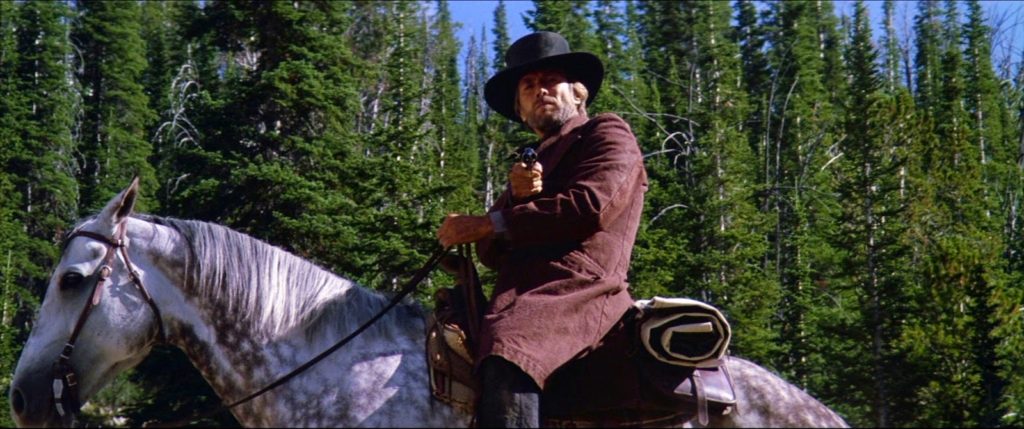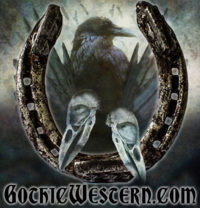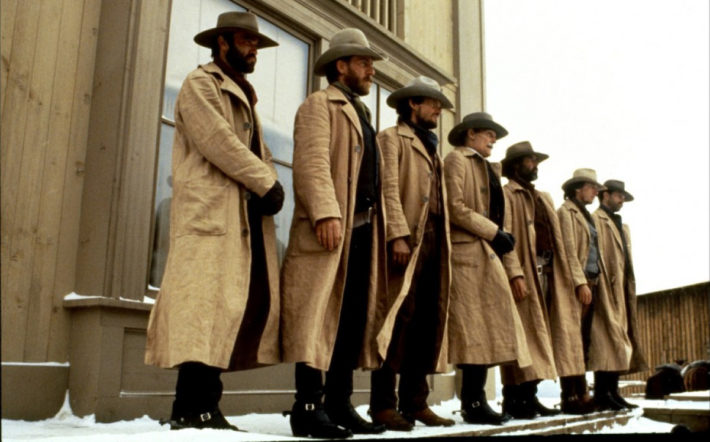The following is the last of a four part series by John Edgar Browning about Clint Eastwood’s Pale Rider (1985), taken from “Undead in the West II: They Just Keep Coming“, a book chronicling films in the American Gothic Western and Weird Western genre.
In the guise of the mysterious stranger, or “Man with No Name,” Eastwood’s character in Pale Rider, as in High Plains Drifter, assumes the role of “a gothic avenger from some other plane of being.” Paradoxically, it is only by virtue of the protagonist’s otherworldly origins and abilities that the seemingly implausible in both these films is even conceivable. In another pivotal scene, just after Stockburn and his deputies have arrived, LaHood’s mining office in town is imbued with some of the same Gothic elements. LaHood and Stockburn stare curiously out an office window at a Carbon Canyon prospector who stands drunkenly in the streets outside. The interior of the office is shrouded in almost impenetrable darkness, and LaHood’s attire, black linen, blends seamlessly into the surrounding gloom; LaHood’s face has the illusion of just hanging there in the shadow. Behind LaHood and Stockburn in the darkness, the deputies stand in complete silence, unsmiling, unblinking, their white dusters eerily silhouetted in red by the fire, revealing their true, evil visage. A conversation (reminiscent of one in Shane) between LaHood and Stockburn reveals Preacher’s possible origin, adding to his ghostly character:
Stockburn: What did this preacher look like ?
Lahood: He was tall and lean. His eyes. Yeah, his eyes . . . something strange about them. Stockburn turns towards LaHood.
Lahood (cont’d): That mean something to you? Stockburn returns his gaze out the window.
Stockburn: Sounds like a man I once knew.
Lahood: Might be. He recognized your name. Stockburn whips his head back around towards LaHood and glares for a moment, then returns his gaze towards the window.
Stockburn: Couldn’t be. The man I’m thinking about is dead.
Stockburn’s last remark alludes to an earlier scene in which we see the Preacher changing shirts, revealing on his torso the scars of six (almost assuredly fatal) bullet wounds— his “Christlike stigmata,” which create a striking parallel between Preacher and the figure of the arisen Christ. In the final showdown between the Preacher and Stockburn, the Preacher fires six bullets into Stockburn’s torso. Stockburn, after receiving a final bullet to the forehead, falls limp as Hull walks up and stares quietly at his lifeless form. Noticing the bullet pattern on Stockburn’s torso, Hull glances with a shocked expression at the Preacher.
 The character of Preacher comes by the end of the film to embody the American Gothic Western. Although he retains the usual “collection of external gestures, mannerisms, and stylish articles of clothing,” Preacher exudes in Pale Rider a clear sense of morality, overtly heroic actions, and fundamental concern with the welfare of Carbon Canyon, effectively separating him from his Gothic antecedents in the Eurowestern. More still, the gradual unfolding of Preacher’s personal history over the course of the film, a history that culminates with the pattern of the wounds sustained by Stockburn, grants us, as no film had ever done up until that point, private access to the antihero’s “inner man.” While Eastwood plays with this theme in High Plains Drifter, he extends and arguably perfects it in Pale Rider. That we as viewers are permitted to glimpse the interworkings of a fundamentally moralistic antihero deeply steeped in the Gothic mode is uniquely American. Conclusions: Economic Crises and the Gothic Western Gothic aesthetics and the grammars of horror have played roles both in the Eurowestern and in Eastwood’s Gothic American Westerns, but the Gothic is also fundamentally tied to the economic crisis in Pale Rider. The Gothic aesthetics that I outline here, particularly those in Leone’s Eurowesterns, make possible the pursuit of capital gain without moral or ethical repercussions. However, this trend begins to shift in Eastwood’s first Gothic American Western, High Plains Drifter, in which the vengeful spirit played by Eastwood essentially “polices” the money-grubbing community whose avarice made it responsible for his death. The moral and ethical crusade in High Plains Drifter becomes more pronounced in Pale Rider, wherein “avarice” and “the community” become entirely separate— and, indeed, diametrically opposed— entities. “The community” (embodied by the colony at Carbon Canyon) represents the working class, family values, and spirituality, which together imbue it with a sort of “moral code” that permits its ethical pursuit of material and capital gain. The inclusion of Gothic tropes in Pale Rider, however, does not function in the same way that it does in Leone’s Eurowesterns, where it is the protagonists who exhibit LaHood’s ruthless, amoral pursuit of money. Instead, the Gothic in Pale Rider supplies the narrative with a technology for representing the irrationality and instability inherent in economic crises. LaHood’s “hydraulic mining [hurts] not only the environment . . . but also the economic welfare of those [affected] by the dammed rivers and streams.” The binary opposition of good and evil that Pale Rider sets up between Preacher (violent, disinterested in material or capital gain) and LaHood (violent, obsessive in pursuit of material and capital gain) is, Heumann and Murray suggest, complicated, if not deconstructed, by the inclusion of Hull Barret and his community (peaceful, moderate in pursuit of material and capital), who offer an alternative to both. Preacher’s character “both protests against and mimics that o f’ LaHood and his men. However, the importance of the Gothic in Pale Rider is not simply in its representation of the economic despair instigated by LaHood but in its provision of a solution (albeit a supernatural one) to the problem of stopping him. Hull and his community cannot legally stop LaHood, since “there is no function ing legal system in town.”
The character of Preacher comes by the end of the film to embody the American Gothic Western. Although he retains the usual “collection of external gestures, mannerisms, and stylish articles of clothing,” Preacher exudes in Pale Rider a clear sense of morality, overtly heroic actions, and fundamental concern with the welfare of Carbon Canyon, effectively separating him from his Gothic antecedents in the Eurowestern. More still, the gradual unfolding of Preacher’s personal history over the course of the film, a history that culminates with the pattern of the wounds sustained by Stockburn, grants us, as no film had ever done up until that point, private access to the antihero’s “inner man.” While Eastwood plays with this theme in High Plains Drifter, he extends and arguably perfects it in Pale Rider. That we as viewers are permitted to glimpse the interworkings of a fundamentally moralistic antihero deeply steeped in the Gothic mode is uniquely American. Conclusions: Economic Crises and the Gothic Western Gothic aesthetics and the grammars of horror have played roles both in the Eurowestern and in Eastwood’s Gothic American Westerns, but the Gothic is also fundamentally tied to the economic crisis in Pale Rider. The Gothic aesthetics that I outline here, particularly those in Leone’s Eurowesterns, make possible the pursuit of capital gain without moral or ethical repercussions. However, this trend begins to shift in Eastwood’s first Gothic American Western, High Plains Drifter, in which the vengeful spirit played by Eastwood essentially “polices” the money-grubbing community whose avarice made it responsible for his death. The moral and ethical crusade in High Plains Drifter becomes more pronounced in Pale Rider, wherein “avarice” and “the community” become entirely separate— and, indeed, diametrically opposed— entities. “The community” (embodied by the colony at Carbon Canyon) represents the working class, family values, and spirituality, which together imbue it with a sort of “moral code” that permits its ethical pursuit of material and capital gain. The inclusion of Gothic tropes in Pale Rider, however, does not function in the same way that it does in Leone’s Eurowesterns, where it is the protagonists who exhibit LaHood’s ruthless, amoral pursuit of money. Instead, the Gothic in Pale Rider supplies the narrative with a technology for representing the irrationality and instability inherent in economic crises. LaHood’s “hydraulic mining [hurts] not only the environment . . . but also the economic welfare of those [affected] by the dammed rivers and streams.” The binary opposition of good and evil that Pale Rider sets up between Preacher (violent, disinterested in material or capital gain) and LaHood (violent, obsessive in pursuit of material and capital gain) is, Heumann and Murray suggest, complicated, if not deconstructed, by the inclusion of Hull Barret and his community (peaceful, moderate in pursuit of material and capital), who offer an alternative to both. Preacher’s character “both protests against and mimics that o f’ LaHood and his men. However, the importance of the Gothic in Pale Rider is not simply in its representation of the economic despair instigated by LaHood but in its provision of a solution (albeit a supernatural one) to the problem of stopping him. Hull and his community cannot legally stop LaHood, since “there is no function ing legal system in town.”
 The Gothic American Western envisaged in Pale Rider is an amalgam of the idyllic and the grotesque— a fusion of the Gothic Eurowestern and the classic American Western. McGee suggests, “In response to the social disillusionment that grew in the United States as a result of political strife, assassinations, strife, and the Vietnam War,” the Westerns of Leone and Eastwood “are more pessimistic than the films of the classical period.” Yet, Pale Rider represents, in some ways, a return to more conservative ideologies, a quality that is not at all consistent with the capital narratives that we see in Gothic Eurowesterns such as the Dollars Trilogy. Interestingly, it is this return that probably helps to make the Gothic American Western decidedly “American” in flavor.
The Gothic American Western envisaged in Pale Rider is an amalgam of the idyllic and the grotesque— a fusion of the Gothic Eurowestern and the classic American Western. McGee suggests, “In response to the social disillusionment that grew in the United States as a result of political strife, assassinations, strife, and the Vietnam War,” the Westerns of Leone and Eastwood “are more pessimistic than the films of the classical period.” Yet, Pale Rider represents, in some ways, a return to more conservative ideologies, a quality that is not at all consistent with the capital narratives that we see in Gothic Eurowesterns such as the Dollars Trilogy. Interestingly, it is this return that probably helps to make the Gothic American Western decidedly “American” in flavor.
John Edgar Browning



